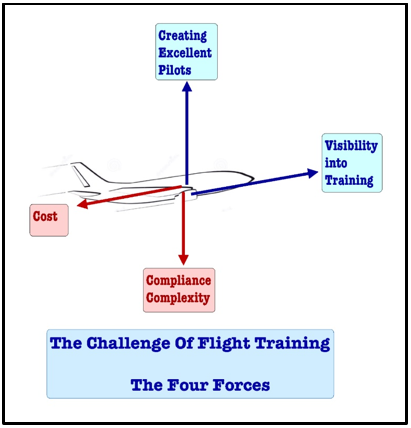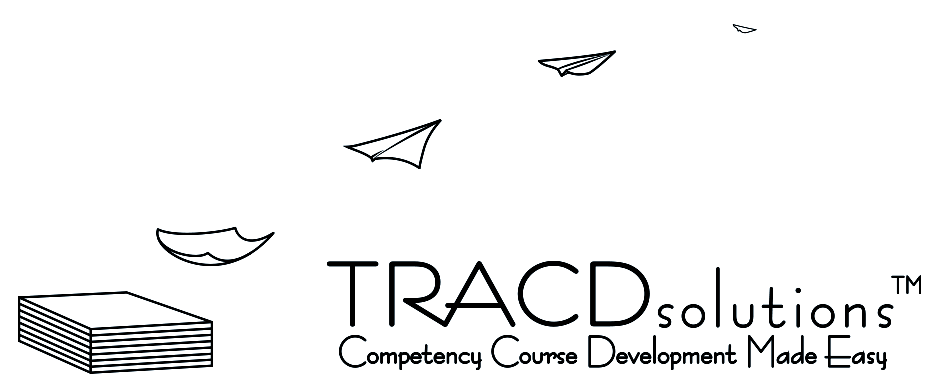The Four Forces of Training - Part 1
The great challenge of flight training is not to balance the four forces (there is no profit in that), but through management actions to set the two forces of “Visibility” and “Creating Excellent Pilots” to their maximum and to minimize the effects of “Cost” and “Compliance Complexity”. This will provide you with acceleration and growth in your business.
In this 4 part article I will look at the issues and solutions for these 4 forces. Let’s commence with a focus on the important force of maximizing Visibility into the training process:
![]() Overview: The HOO, Instructors and students must all be able to visually “see into” where the student is at in their training course without having to gather up all the files – what training is completed, flight and briefing hours, and what are the lessons coming up next. Digital, cloud and mobile technology make this easy to gather the data a present it in visual easy to read shapes. This feature allows for efficient and pro-active scheduling by any staff to keep students “in the air”.
Overview: The HOO, Instructors and students must all be able to visually “see into” where the student is at in their training course without having to gather up all the files – what training is completed, flight and briefing hours, and what are the lessons coming up next. Digital, cloud and mobile technology make this easy to gather the data a present it in visual easy to read shapes. This feature allows for efficient and pro-active scheduling by any staff to keep students “in the air”.
![]() Oversight: The HOO must be able to monitor a cohort of students to check that they are all progressing at a suitable rate to remain as a group through the course. If the cohort breaks apart, you lose the synergies of mass briefing and course progression. This allows for significant efficiencies and reduced costs.
Oversight: The HOO must be able to monitor a cohort of students to check that they are all progressing at a suitable rate to remain as a group through the course. If the cohort breaks apart, you lose the synergies of mass briefing and course progression. This allows for significant efficiencies and reduced costs.
![]() Preparation: Each student must be able to preview their next lesson plan (dual or solo) and see the detail of what they will do so that they can effectively prepare before being given a pre-flight briefing. This allows for clear insight for the student and results in safer and more effective training as well as providing student motivation.
Preparation: Each student must be able to preview their next lesson plan (dual or solo) and see the detail of what they will do so that they can effectively prepare before being given a pre-flight briefing. This allows for clear insight for the student and results in safer and more effective training as well as providing student motivation.
![]() Communication: Students and instructors must be able to easily communicate. Whilst email and text messages might achieve this, communication inside a training platform keeps the student connected to your brand, your company, and enhances student retention. This allows for reduced drop out, greater motivation and higher completion rates.
Communication: Students and instructors must be able to easily communicate. Whilst email and text messages might achieve this, communication inside a training platform keeps the student connected to your brand, your company, and enhances student retention. This allows for reduced drop out, greater motivation and higher completion rates.
![]() Status: Students and instructors must be able to see what items have not been taught, or what items the student has been assessed on but was not deemed competent. This allows student focus for their preparation to improve their training outcomes.
Status: Students and instructors must be able to see what items have not been taught, or what items the student has been assessed on but was not deemed competent. This allows student focus for their preparation to improve their training outcomes.
![]() Efficiency: The HOO must be able to monitor individual students without having to track down the file or the instructor and see those that are not progressing at a suitable rate and are in danger of dropping out. This allows for intervention to prevent student drop out and loss of income.
Efficiency: The HOO must be able to monitor individual students without having to track down the file or the instructor and see those that are not progressing at a suitable rate and are in danger of dropping out. This allows for intervention to prevent student drop out and loss of income.
![]() Outcomes: Students and instructors must be able to see Knowledge Deficiency Reports (KDRs) generated for all the inhouse student exams (pre-solo, pre area solo, pre licence test etc). This allows the students to clearly focus their learning on what has yet to be achieved.
Outcomes: Students and instructors must be able to see Knowledge Deficiency Reports (KDRs) generated for all the inhouse student exams (pre-solo, pre area solo, pre licence test etc). This allows the students to clearly focus their learning on what has yet to be achieved.
![]() Completion: The HOO must be able to easily and clearly see that all required Units, Elements and individual Performance Criteria and Underpinning knowledge have been correctly completed through the training and see the evidence of dates or lesson numbers that show where the teaching or assessing occurred as required by 61.195 (2) (a) & (c).
Completion: The HOO must be able to easily and clearly see that all required Units, Elements and individual Performance Criteria and Underpinning knowledge have been correctly completed through the training and see the evidence of dates or lesson numbers that show where the teaching or assessing occurred as required by 61.195 (2) (a) & (c).
What “visibility” aspects are most important for you in your training? What areas do you need to work on? If you would like to see how TRACDsolutions solves this problem of the 4 forces and can provide you with a solution that will minimize your costs and drag and maximize your profits and results, just head over to www.sigginsaviationconsulting.com.au/TRACDsolutions or give me a call on 0411041636 (respect my WST sleep in!). In the next articles I will cover the remaining 3 forces.
Hadyn Siggins.

